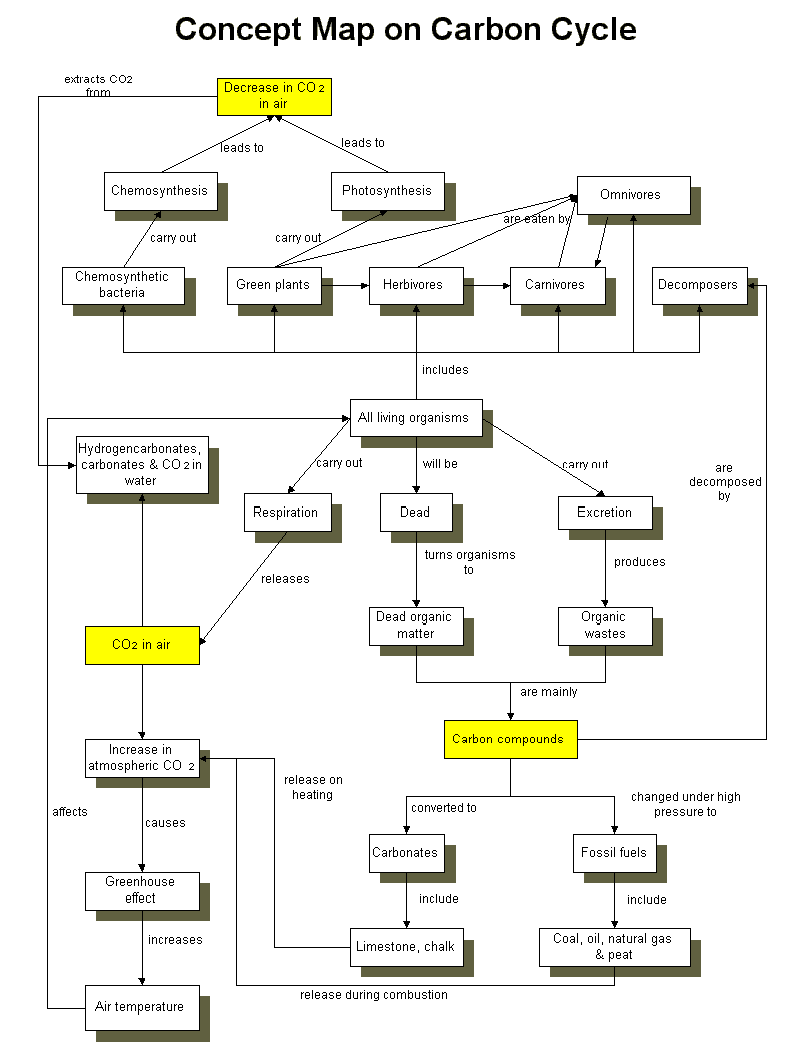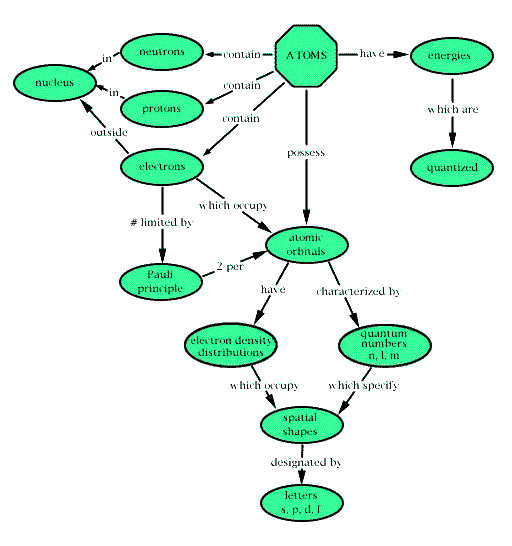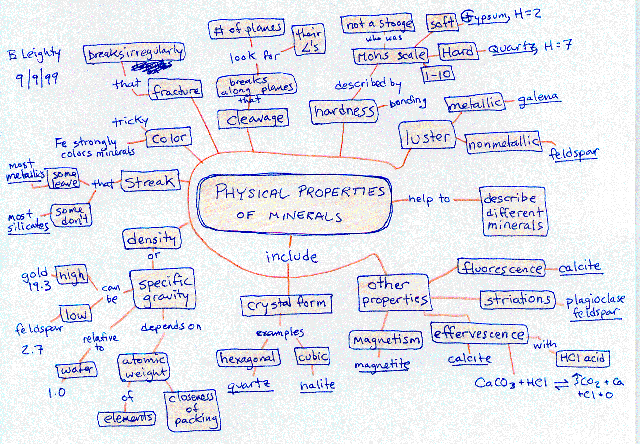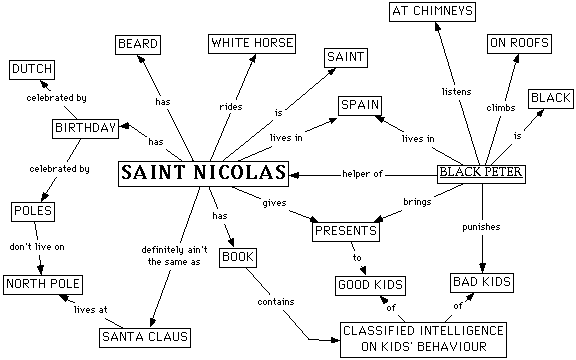| A
concept map is a graphical representation of concepts
and their interrelationships. Concept mapping is a technique
that allows you to understand the relationships between
ideas by creating a visual map of the connections. The
concept mapping technique was developed by Prof. Joseph
D. Novak at Cornell University in the 1960s. This work
was based on the theories of David Ausubel, who stressed
the importance of prior knowledge in being able to learn
about new concepts. Novak concluded that "Meaningful
learning involves the assimilation of new concepts and
propositions into existing cognitive structures".
In the words of Novak and Gowin (1984), a concept map
is a "schematic device for representing a set of
concept meanings embedded in a framework of propositions."
Concept maps are comprised of nodes (concepts) and
links (lines), arranged hierarchically or in some other
order to reflect the information domain being represented.
Nodes represent concepts and links represent the relations
between concepts. Links can be non-, uni- or bi-directional.
Concepts and links may be categorized, they can be simply
associative, specified or divided in categories such
as causal or temporal relations.
A concept map can be an effective tool for organizing
new information and integrating it with existing knowledge.
The act of constructing concept maps helps learners
to recognize new relationships among concepts and refine
their understanding of existing relationships (Anderson-Inman
& Zeitz, 1993). Because concept maps are externalized
representations of the learner's knowledge they can
also be effective tools for revealing misconceptions.
Concept maps allow you:
- to see the connections between ideas you already
have (which can be helpful in studying for a test);
- to connect new ideas to knowledge that you already
have (which can help you organize ideas as you find
them in researching a paper; and
- to organize ideas in a logical but not rigid structure
that allows future information or viewpoints to be
included (which can help you decide how you want to
organize a paper).
Concept mapping looks like clustering (a type of freewriting
that is almost completely unstructured and that works
by free association), but it goes one step further by
revealing a clear relationship between the ideas that
you're writing about. While concept mapping is more
structured than prewriting, it is less structured and
more flexible than formal outlining (which puts ideas
in a sequence and organizes them by hierarchy or levels
of importance), and so it allows you to see more complex
relationships between ideas than just sequence and hierarchy.
Concept mapping can be done for for several purposes:
- to generate ideas (brain storming, etc.);
- to design a complex structure (long texts, hypermedia,
large web sites, etc.);
- to communicate complex ideas;
- to aid learning by explicitly integrating new and
old knowledge;
- to assess understanding or diagnose misunderstanding.
To create a concept map, you should first read widely
on your subject until you can list key concepts or ideas
and several examples. A concept is an abstract idea
that is not limited to just one place or time. An example
is one instance of a concept. For example, "subliminal
advertising" is a concept and "Seagram's advertisement
in Newsweek" is an example of the concept. The
following steps allow you to build a concept map; remember
that you can create many different maps from the same
list, depending on how you interpret the relationships
between ideas.
The process of building a concept map is comprised
of four major activities:
- identifying the main topic or key concept of the
map by enclosing it in a graphic element (called a
node);
- entering subordinate concepts in similar nodes that
radiate from the key concept;
- identifying the relationship between each subordinate
concept and the key concept by creating and labeling
a link (line) between the two; and
- repeating this process as information is added to
the map and more conceptual relationships between
and among concepts are portrayed.
Relationships included on a concept map are usually
of two kinds: propositions (or sentence-like statements
about the relationship of one concept to another) and
examples (a specific type of relationship in which one
of the linked concepts is an example of the other).
Because learning is often best achieved when details
are organized under broader, more general categories,
concept maps are usually hierarchical in form, with
the most general concept (the main topic or key concept)
at the top or in the middle. The steps involved in making
a concept map are outlined below:
- Transfer the concepts and examples to small pieces
of paper or post-it notes (you may want to use different
colors for concepts and examples) or simply make a
list of the concepts and examples to be mapped. .
Concepts are signified by a noun or short phrase equivalent
to a noun.
- Choose the most general, or the main, idea. Write
it down on a large sheet of paper or poster board
and draw a circle or box or cloud (etc.) around it.
- Arrange the pieces of paper of other concepts on
the large sheet of paper or poster board around the
central idea, with the broadest or most abstract ideas
closest to the central idea and the most specific
ideas far from the central idea. Furthermore, the
closer concepts are to the central idea, the more
directly they are related to the main idea. If two
or more concepts bear the same relationship to the
main idea, they should be placed at the same level.
Do not include the examples yet.
- Keep related concepts together. At this point, you
may wish to add concepts that help explain, connect,
or expand the ideas that you have.
- Draw lines from upper concepts to lower concepts
that they're related to; do the same for any related
concepts that are on the same level. You may decide
to rearrange the pieces of paper or concepts during
this stage.
- This is the most important and most difficult step:
on the connecting lines, write words or short phrases
that explain the relationship of the concepts. For
example, you could connect the concept "extracurricular
activities" to the concept "resume"
with the phrase "should not be included on"
(in other words, a resume should not contain a list
of extracurricular activities. You may continue to
rearrange the pieces of paper to make the relationships
easier to visualize.
- Put the examples under the concepts they belong
with, and connect the concept to the example with
a phrase like "for example". Copy the results
of the above steps onto a single sheet of paper. Instead
of post-it notes, draw circles, boxes, etc. around
the concepts. Drawing circles, boxes and etc. around
examples is optional. Consistency in the style of
shapes drawn is critical.
Here are some other examples of concept maps (of varying
quality):




Here is a list of software that could be used to draw
concept maps. Some of them of limited trial offers that
would allow you to use the program for free. You are
not expected to use software to complete your assignment
and this is not an endorsement for any of these software
packages.
Inspiration
Software
Decision
Explorer
IHMC Cmap
FreeMind
XMind
iMindMap Desktop Software
NovaMind
http://users.edte.utwente.nl/lanzing/cm_home.htm
http://www.rit.edu/~easi/itd/itdv05n1-2/article2.html
http://www.gpc.edu/~shale/humanities/composition/handouts/concept.html
http://qsad.bu.edu/ed/TeacherLog/conceptgifs/
http://www.fed.cuhk.edu.hk/~johnson/misconceptions/concept_map/carbon_cycle.html
http://www.mc.maricopa.edu/dept/d43/glg/Study_Aids/concept_maps/cm_physprops.html
|




